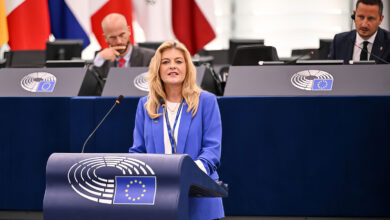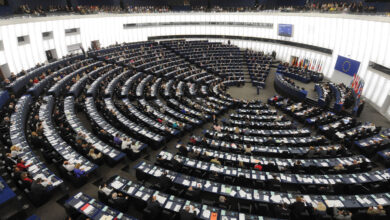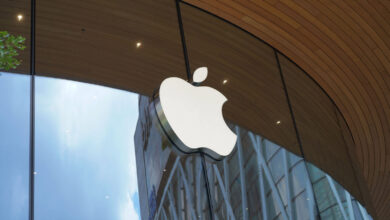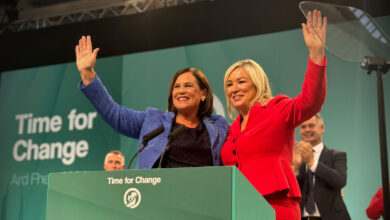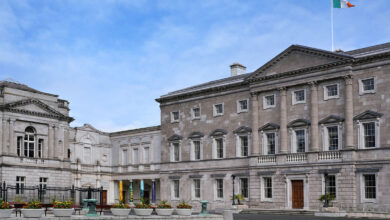The importance of Leaders’ debates
Theresa Reidy examines the role Leaders’ debates play in the outcome of elections.
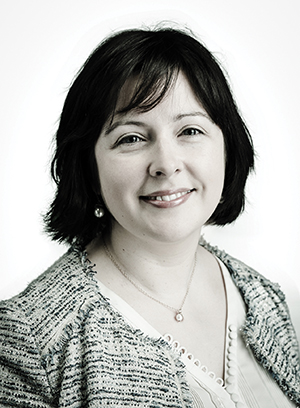
The 2016 general election campaign had a strong presidential dimension to it. The leaders of all the parties were front and centre of their party strategies and this aspect was amplified by the decision to hold three leaders’ debates over the course of the campaign. Although the campaign was quite short, it lacked intensity. Often, the points of policy difference between the parties seemed muted and the personal attributes of the leaders were important talking points along with their respective positions on which parties they would or would not form coalitions with in the aftermath of the vote.
Television debates
Televised candidate debates have become a mainstay of elections since the 1960s. The Kennedy-Nixon debate in 1960 is often cited as the original of the species and it set in train an aspect of election folklore which has proven difficult to dislodge ever since; the idea that the debates are decisive, delivering election victory to the most effective performer.
Each debate tends to bring intense focus on who has won. Media speculation before, and scrutiny afterwards, talks about winners and losers, killer blows, knock-out punches. This analysis is contrary to the accepted wisdom from international research which tells us that televised debates for the most part, do not substantively impact directly on the preferences of voters. In fact, they tend to have a reinforcement effect. A large proportion of the viewers who tune into candidate debates have pre-existing dispositions towards, and against candidates, in the debates. They are partisans, people with long standing affiliations to political parties or voters who have already made up their minds on how they will vote. On watching the debates, these voters are more likely to emphasise information which aligns with their pre-existing disposition and they discount information which is in conflict with their positions, psychologists writing about this refer to the process as selective perception. In practice, what this means is that there is only a small group of viewers who are open to persuasion. For the debate to be decisive, they would all need to be swayed in the direction of one candidate. In practice this does happen but it is rare.
There is a second strand to the research on televised candidate debates that is focused on mobilisation. This work has produced clearer evidence that debates have an impact. Essentially this research looks at whether debates increase voter knowledge and chances of voting. The balance of evidence is favourable suggesting that candidate debates often result in voters discussing the election with family, friends and colleagues and may result in voters seeking out more information, all of which improves the likelihood that someone will vote. Of course, this aspect of the candidate debate makes for much less interesting post-debate media commentary but it is an angle to remember when calls are made to scrap the debates entirely.
Debate formats
There are different formats to television debates. Originally, the dominant approach was a two-way contest between the two candidates challenging to be the Prime Minister or President. This configuration was used in Ireland from 1982 when the first leaders’ debate took place. As politics has become more fragmented in many countries, pressure has come on the two-way debate format. In multi-party parliamentary systems, there may be more than two candidates challenging to become prime minister. Coalition government is the norm across Europe meaning that the leaders of medium and small parties regularly play a major role in government. The end result is that debates which feature the leaders of just the two largest parties no longer reflect the reality of politics or the information requirements of voters.
Between three and five leaders in debates has become the norm in many countries. The Dutch have developed some of the most innovative solutions, in 2015 they operated a topic based debate where the leaders of 12 parties participated but the structure provided for six mini debates between two leaders at a time. In the 2007 Irish election, the leaders of the smaller parties debated against each other in a lively engagement which featured Pat Rabitte, Michael McDowell and Gerry Adams. By 2011, the formats had changed and the leaders of the smaller parties had joined the main fray. There were two-way, three way and five-way debates. The frequency of debates and participation rules are controversial across the globe. In the UK election in 2015, controversy abounded about the decision by David Cameron to not participate in a head to head debate against Ed Miliband although he did participate in a series of interviews and wider debates. In 2016, the Green Party leader Eamon Ryan took a legal challenge to the decision to exclude him from the RTÉ seven-way debate. His legal challenge was very similar to a struggle which the Green Party has also pursued in Canada in an effort to be included in election debates there.
Linguistic issues also arise in a great many places. In Canada, debates in English and French are expected. The Irish language debate at the 2011 election was widely described as the most informative and interesting but the mixed language skills of the leaders of the main parties mean that an Irish language debate was not possible in 2016.
Election 2016
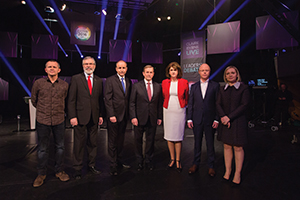 There were just three weeks of campaigning in 2016 and the inclusion of three leaders’ debates inevitably led to them becoming the focal point of the campaign. It is easy to see why, election debates are very popular and more than a million people tuned into the debate moderated by Miriam O’Callaghan in the last week of the campaign. Data from the RTÉ exit poll tell us that 67 per cent of those who voted on 26 February tuned into at least one of the televised debates. Men were slightly more likely than women to have watched one of the debates and there is a clear age effect in the data with just 54 per cent of 18-24 year olds watching a debate while the number rises to 70 per cent for those in the 65+ age category. With such a large proportion of voters tuning in, it is easy to see why parties take them seriously.
There were just three weeks of campaigning in 2016 and the inclusion of three leaders’ debates inevitably led to them becoming the focal point of the campaign. It is easy to see why, election debates are very popular and more than a million people tuned into the debate moderated by Miriam O’Callaghan in the last week of the campaign. Data from the RTÉ exit poll tell us that 67 per cent of those who voted on 26 February tuned into at least one of the televised debates. Men were slightly more likely than women to have watched one of the debates and there is a clear age effect in the data with just 54 per cent of 18-24 year olds watching a debate while the number rises to 70 per cent for those in the 65+ age category. With such a large proportion of voters tuning in, it is easy to see why parties take them seriously.
The RTÉ exit poll also tells us that Micheál Martin was the clear winner for voters with 39 per cent identifying him as the ‘winner’. This finding accords with the analysis of most of the post-debate commentators. But we must return to the point about viewing debates through the eyes of the voters. 10 per cent of voters believed that Gerry Adams won the debate, 8 per cent opted for Enda Kenny, 5 per cent for Joan Burton and even though Lucinda Creighton, Richard Boyd Barrett and Stephen Donnelly only participated in one of the three debates, they also recorded ‘winner’ levels of 3 per cent, 5 per cent and 7 per cent respectively. 23 per cent of voters responded that no one came out best.
To get at the complexity of analysing the debates, we must also include the 2011 results when 32 per cent also thought that Micheál Martin had won the debates, also well ahead of the other candidates. This tells us that we must be careful about implying a causal relationship between winning the debate and winning votes. Micheál Martin won in 2011 and in 2016 but the election results tell us that Fianna Fáil had a disastrous election in 2011 and a greatly improved performance in 2016. One does not lead to the other. However, with such large numbers tuning in and extensive post-debate scrutiny, we cannot discount the debates, they provide a forum for voters to learn about the leaders and their policies, they promote debate and discussion about the election and they may remind voters that polling day is coming very soon.
Theresa Reidy is a political scientist in the Department of Government at University College Cork. Her research interests include party politics and electoral behaviour in Ireland.

